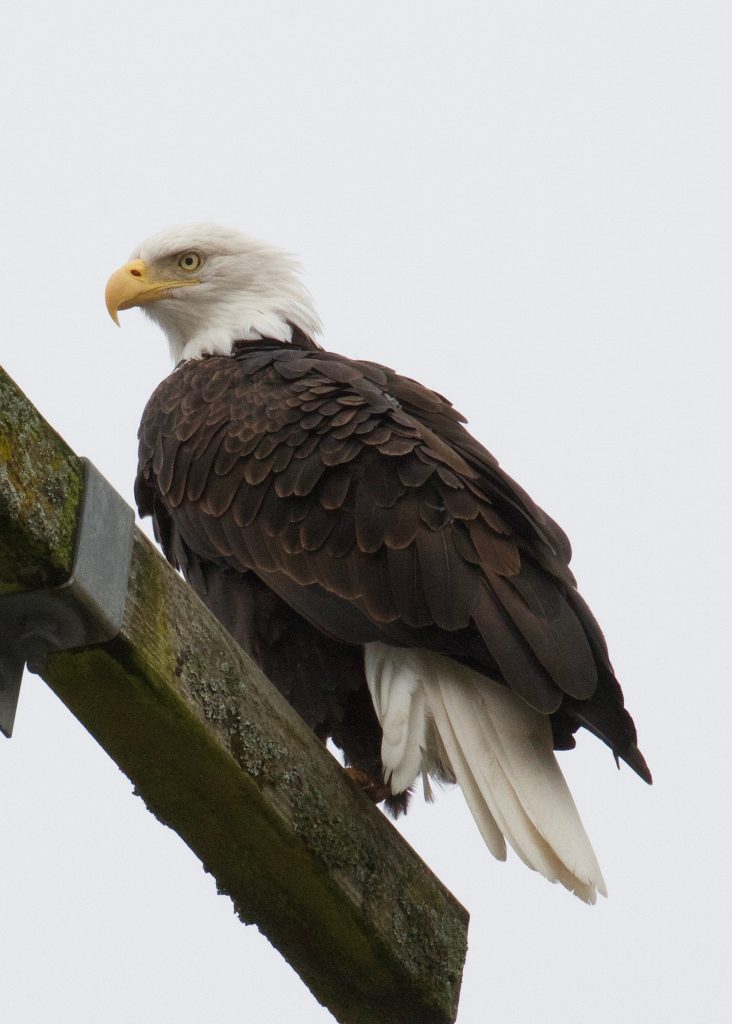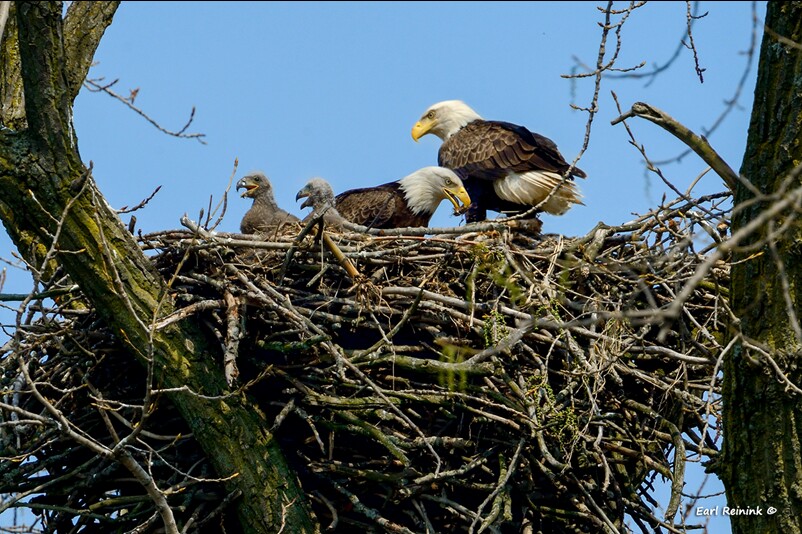Bill’s Post
February 2024

Bill loaning Pope Francis $5.00 for a taxi when he visited Washington in 2015
The Niagara Falls Gazette Sept 28, 1934
Boy of 14 Wins Fight with Eagle King of Air, with “Wing Spread of over Six Feet, Slain.
PORT COLBORNE, Ont., Sept. 28. —No longer from his perch on high looks the bald old eagle that for the past few months spread a reign of terror in the vicinity of Lowbanks, near Port Colborne. The giant bird usually very cautious, ventured to close . . . fourteen-year-old resident of Lowbanks, yesterday . . . wing Spread of six feet 2 1/2 Inches. The American or bald-headed eagle as it is
frequently called, is believed to be the first of its kind killed in this district in recent years.
The bird almost evened the score with the lad who shot him. Using fine buck shot, young Farr winged his quarry, bringing it to earth. The bird, screeching in rage chased the lad, Intent on sinking its claws into the marksman. The youthful hunter, running as fast as he could, observed that the bird was rapidly closing the distance between them and hastily slipped another shell into the gun, turning around and ended the life of the eagle with a load of shot that entered the breast of the bird.
Bill’s comment – It was the above newspaper article which inspired this article. I wanted someone who knew a thing or two about the return of the Bald Eagle to this region. One phone call to another and I found George Naylor. Thank you, George for doing such a great job in telling the story of the Bald Eagle.
The following article has been written by George Naylor who wrote from the Eagle’s perspective.
I share North America with another member of my family – the Golden Eagle. I am larger than my cousin, and am the 2nd largest bird of prey on the continent, smaller only than the California Condor – another species that is critically endangered. An adult Bald Eagle can weigh more than 12 lbs., and have a wingspan of over 8 feet. Females are larger than males in birds of prey – a process called sexual dimorphism. There are 59 members of the Eagle family worldwide, and I am the 3rd largest of my kind in the world. The largest of my kin is the Martial Eagle of N. Africa, followed by the Steller’s Sea Eagle. Without bragging, we look pretty spectacular in adult plumage, with the white head and tail, and black body, but it takes us 5 years from birth to attain this plumage. Immatures are various plumages of brown. We are very similar in appearance to the Steller’s Sea Eagle and the White-tailed Eagle of northern Europe and Asia. Even though I share North America with my cousin, we occupy completely different habitats. The Golden Eagle is a bird of prey of the mountains and forested areas, and their prey is almost exclusively small and medium-sized mammals like rabbits and squirrels. I am always found near water, whether it be lakes, the edges of oceans, or rivers like the Grand River in southern Ontario. Fish and ducks are a large part of my diet, although we will also eat carrion. Golden Eagles build their nests in mountainous areas on cliffs, while our nesting preference is large stick nests in tall trees, nearly always close to water, which is why the Grand River has historically had a large population of my kind. Like others in my family, we mate for life, and will only pair with another after the death of a partner. We are loyal to our nest sites and will return year after year. As part of the bonding process prior to mating, we add new material to this nest every year, and they can become quite large and heavy, sometimes containing 2 tons of material. There have been some instances of the weight of the nest causing the nest tree to fall over.

Bald Eagle Photo by George Naylor
In the past, we were respected and even revered by the original settlers of this continent, and Eagle feathers were worn proudly as a badge of honour and a sign of bravery. The First Nations peoples never hunted us for our feathers, but would acquire the feathers after a death, or when we lose them and grow new ones through the molt process, which happens yearly.
Our populations were healthy, and thrived on this continent throughout history since the last Ice Age, populating every corner of North America that had suitable habitat. The trouble started with the European emigrants who began settling here about 500 years ago, thinking they had discovered North America. They immediately realized the abundance of natural riches here, and set about exploiting those riches for wealth and power. Unlike the First Nations peoples, they treated the land and its animals like property, and some animals like an enemy that had to be exterminated. As European settlers dominated North America, the population switched from a subsistence economy to organized agriculture of both plant products like grain, and the raising of domestic animals. As farming intensified, the pressure on my kind increased. Although we Bald Eagles were chosen as the national symbol of the United States of America, we were considered vermin, and hunted and shot mercilessly, or poisoned with strychnine, because we were viewed as direct competition for animal resources, or as a predator of domestic livestock. The governments of the day reinforced this practice by passing laws encouraging this behavior – declaring war on all predatory animals, both birds and mammals. Often, bounties and cash rewards were given for proof of the destruction of these animals, all the while, never realizing that predators played an important role in maintaining a balance in nature. Bizarre practices like pole-tapping were legalized, where a farmer could put a leg-hold trap on top of a barnyard pole, and trap predatory birds indiscriminately. In most cases, the birds weren’t hunting the livestock, but looking for the mice and rats that have always accompanied the practice of farming. This practice of pole-trapping continued in Ontario well into the mid-20th century. In 1997, a more current publication of The Hunting and Tapping Regulations from the Ontario Ministry of Natural Resources stated, a person shall not hunt or trap specially protected wildlife, or any bird that belongs to a species that is wild by nature, and is not a game bird.
But of all the destructive practices in this Perfect Storm of threats to our kind including habitat loss, shooting and poisoning, the invention and marketing of the pesticide DDT (Dichlorodiphenyltrichloroethane) accelerated the pace of our destruction. This new pesticide was designed to eliminate destructive insect pests in agriculture and increase crop yields to feed a growing population. It also greatly increased the profits of these chemical companies, and even after evidence started to accumulate that DDT was creating very destructive biological side-effects in all living things, (Homo Sapiens too) the companies resisted the recognition of the problem and tried to bury the evidence or argue with the evidence of scientific conclusions. Because birds of prey like myself are called Apex Predators, this means that we suffer from the concentration of this chemical as it works its way up the food chain to us. The Environmental Protection Agency finally banned the use of DDT in the USA in 1972, and Canada quickly followed suit. That sounds like good news, until we discover that DDT is still in use in many parts of the world today, like South America, Africa and Asia. As a result of this ban on our continent, birds of prey could in theory start to recover. However, this continued use of DDT in the rest of the world helps to maintain the profits of these chemical companies, but also maintains the threat for any of us that seasonally migrate to any of these continents!
A high concentration of DDT is harmful to all life, but in respect to large predatory birds, the chemical prevented the formation of healthy eggs and caused the thinning of the egg shells, because it destroyed the birds ability to provide enough calcium for this process. Egg shells would crack and be destroyed just by the weight of an adult bird, and even for eggs that escaped this fate, the concentrations of the chemical passed to the embryo from the parents prevented healthy chick development. We Bald Eagles were disappearing, but also Peregrine Falcons, Ospreys, and most birds of prey. In Ontario. The effects of DDT on my family was so devastating, that historical populations plummeted, and by the 1950s, there were few active Bald Eagle nests on any of the lower Great Lakes, or any of the tributary rivers that fed them. In 1973 the Ontario Ministry of Natural Resources was the first provincial agency to declare Bald Eagles endangered. As quoted in a book written by local naturalist Bob Curry, it stated in the Birds of Hamilton & Surrounding Areas, that there is only one recorded Bald Eagle nest in the Hamilton Study Area from the 1950s on a small lake west of the Grand River near Glen Morris. The book further stated that by the 80s, there were less than 10 breeding pairs of Bald Eagles in all of southern or central Ontario, and the species had experienced complete reproductive failure. We had completely disappeared from the Grand River watershed.
Programs for the reintroduction of birds of prey, including Bald Eagles were started by concerned citizens and scientists in the 1980s, after the ban on DDT. To avoid the destruction of eggs and maximize the production of young birds, the Canadian Wildlife Service took eggs laid by birds from natural nests, particularly from healthy birds in remote areas, or produced by captive-raised adults, and incubated them to minimize egg loss and maximize breeding success. Once the young eaglets reached the target age of 3 – 4 weeks, they were then transferred to artificial nest platforms to continue their growth. The eaglets were cared for until they had grown to the stage where they could fly, and disperse from the nest naturally. This process is called hacking, and often citizen-science groups volunteered and helped raise these young raptors. The Hamilton Naturalists Club (HNC) under the leadership of the late Bruce Duncan was instrumental in building a hacking tower at Taquanyah Conservation Area near the south shore of the Grand River, just west of Cayuga. In 1986 and 87, a male and female were raised to maturity, and left the nest in each of those years. Later in the summer of 86, the male was shot by a farmer N. of Quebec City, because it was examining the chickens in his coop. From 1983 -87, 24 captive-raised Bald Eagle chicks were released from an artificial nesting platform on Long Point. In a parallel conservation effort, the HNC also had a Peregrine Falcon hacking box built atop Mohawk College in Hamilton, where 4 falcon chicks were raised and released. In these hacking programs, it was critical that we be protected but fed naturally, to prevent human contact with the young birds. This cautionary practice prevented placing a human imprint on them, and preserved their natural fear of people.

Bald Eagles nesting in the lower Grand by Earl Reinink
The sun has started to peek through the very dark clouds threatening our survival. In 1980, a large cooperative program with biologists and citizens called the Ontario Breeding Bird Atlas (OBBA) was started. This was a five-year effort by volunteers who would canvas the entire landmass of Ontario to determine the range and population density of all the provinces breeding birds. The plan was to update this atlas every 20 years. When the OBBA was published after the data collection period from 81 – 85, it provided stark proof of the plight of Bald Eagles in Ontario. We were present in the north and west of Ontario, but the situation in southern Ontario was dire. There was no sign of any of our nests on Lake Ontario, and only 6 nests on the north shore of Lake Erie, including a nest at Long Point. There were 2 nests in the E. Central zone, and 2 nests up near Sault Ste. Marie.
A second edition of the Ontario Breeding Bird Atlas was started for the period 2001- 2005, and after 5 years of atlas data submission, the picture for we Bald Eagles and all our allies was quite a bit brighter. After the dire situation in the 1980s when we were endangered, our population has increased since the first OBBA. The 2nd atlas dataset showed an increase of confirmed nests, with 8 on Lake Erie, 2 on Lake St. Claire, 3 in E. Central, and 4 along the N. shore of Georgian Bay from Sault Set Marie to Espanola. There were still none of us on either Lake Ontario or the Grand River.
The 3rd OBBA atlas is now underway, and the health of my family is vastly improved. The sighting of a Bald Eagle is no longer rare in southern Ontario. Burlington Bay in Hamilton has become a favored wintering spot for our kind, and on a good day you can see a dozen eagles in the trees around the Bay or on the ice. Atari three years of survey data starting in 2021, numerous Bald Eagle nests have been recorded all over southern Ontario. If a line was drawn across southern Ontario west from Toronto, the part of our province south of this line shows about 120 active Bald Eagle nests where breeding has been confirmed, and more important, the successful rearing and fledging of a healthy number of eaglets. The new atlas has recorded 11 active nests along the N. shore of Lake Ontario, and an incredible 31 confirmed nests along the N. shore of Lake Erie! On the lower Grand River watershed, 6 active nests have been found, and 4 nests along the Ontario side of the Niagara River. There is also an active nest on an island on Lake Niapenco in the Binbrook Conservation Area. Two of the six productive nests on the Grand are located in the area from Dunnville to the mouth of the river at Port Maitland.
Speaking for my Bald Eagle family, I would like to thank the citizens and scientists who cared enough to recognize the serious problems that were harming us, learned from the mistakes of the past, and cared enough to find ways to undo some of the threats to our existence. My kind are perfectly evolved to survive with the conditions on Planet Earth, if people would learn to just let us be. On behalf of all my family in Ontario I would like to say – Bald Eagles are Baaaack!
George Naylor
